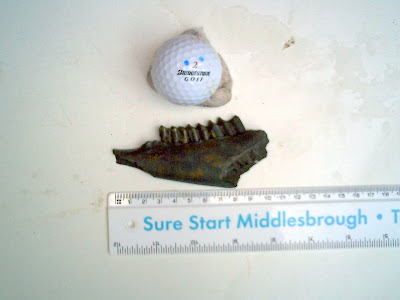Found these fossil bones yesterday in the south west Middlesbrough area of Cleveland.
The intact metatarsal weighs 570 grams
1. 1/4 lbs and measures 305mm/12 inches
long, 75mm at its widest point.
The largest is a metatarsal from a large horse
the condition of this bone shows how protected
its been since being burried!
The ribs are from unknown mammals possibly
horse and deer. The pelvis piece could be deer?
This large pelvis piece i believe to be horse
all the bones are hevily mineralized, and undamaged
like all my bone finds ie no defleshing marks
or bite marks.
Note the excelent condition of the bone
surface!
 I think these jaws are bovine what type i don't no yet any help would be welcome.
I think these jaws are bovine what type i don't no yet any help would be welcome. 





































